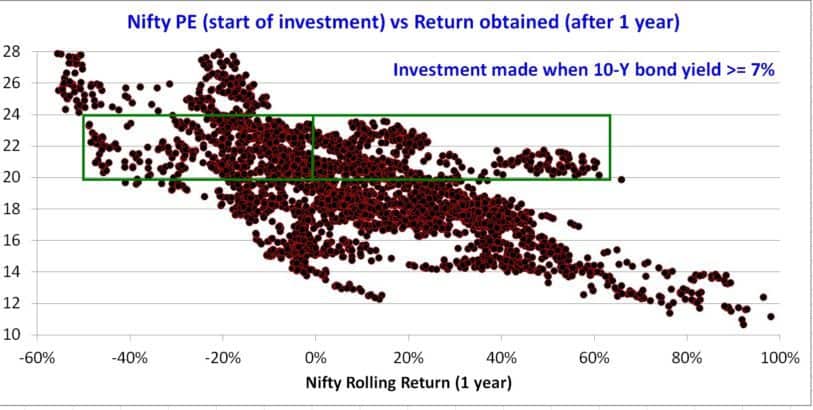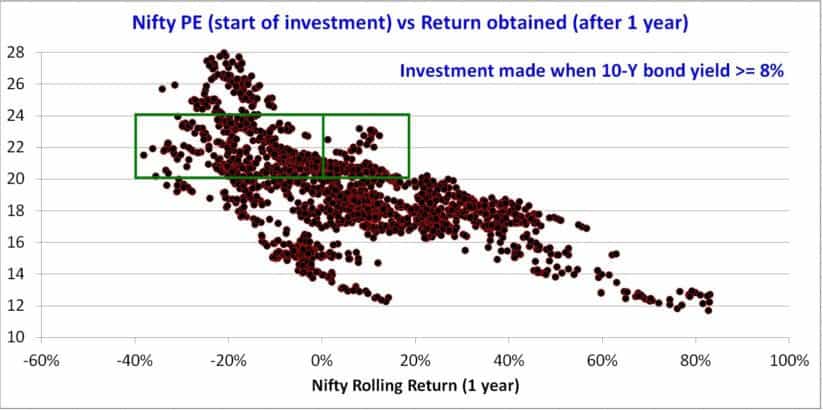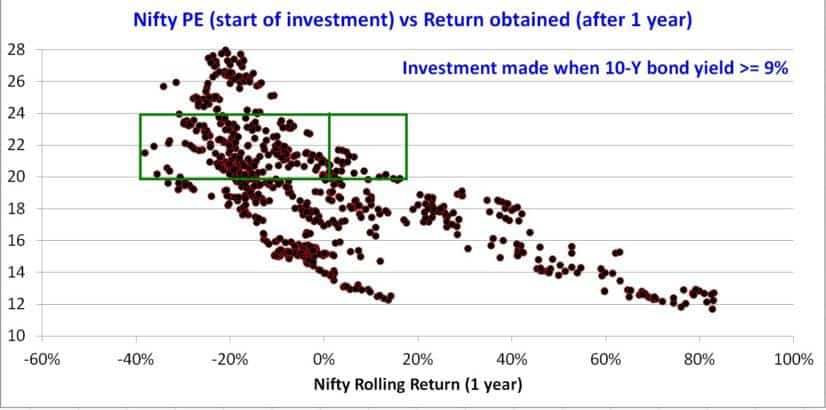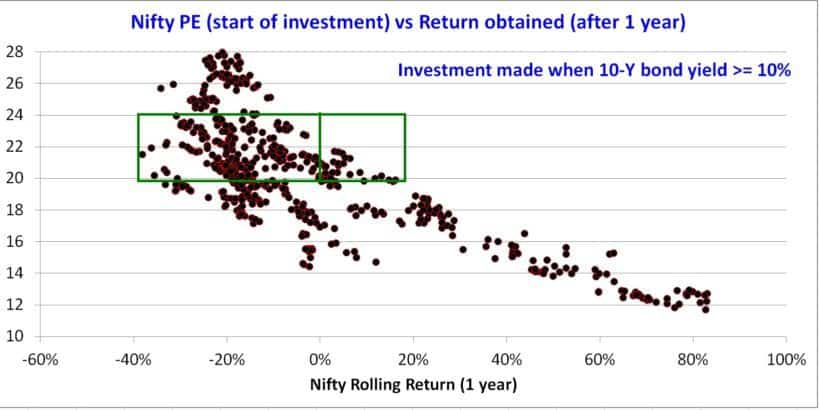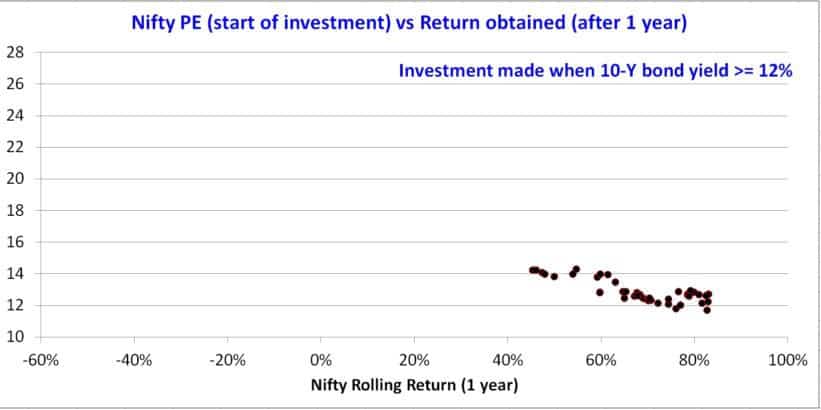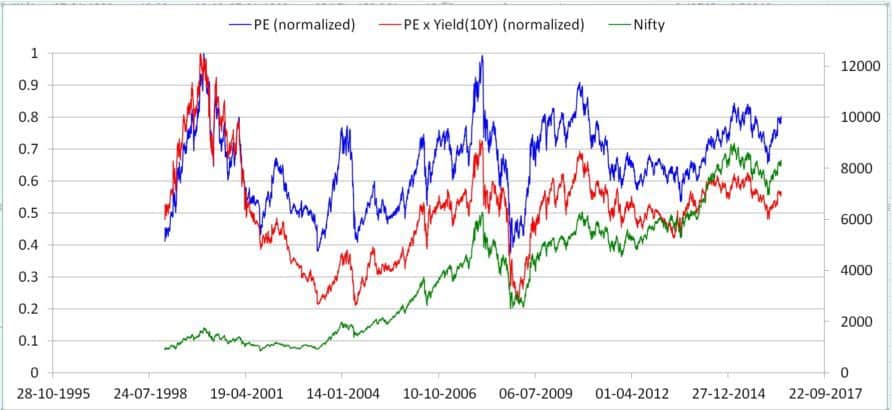Last Updated on December 18, 2021 at 10:35 pm
The correlation between the Nifty PE and long-term bond yield (10-year GOI bond) is discussed in this post. I had earlier considered the relevance of the Nifty PE for the long-term investor and misconceptions about the Nifty PE.
A few days ago, I had asked, what is a high index PE?. There were two interesting comments by Deep and K
This yield is indicative of prevailing interest rate scenario. RBI decides the overnight (policy) interest rate by considering the overall state of the economy. The short-term bond yields closely follow the policy rate. The long-term rates are governed by supply and demand but still depend on the policy rate.
Join 32,000+ readers and get free money management solutions delivered to your inbox! Subscribe to get posts via email! (Link takes you to our email sign-up form)
🔥Want to create a complete financial plan? Learn goal-based investing? Exclusive access to our DIY tools? Increase your income with your skills? Enjoy massive discounts on our robo-advisory tool & courses! 🔥
In what follows, the Nifty PE at the time of investment is plotted against the return from Nifty after 1 year.
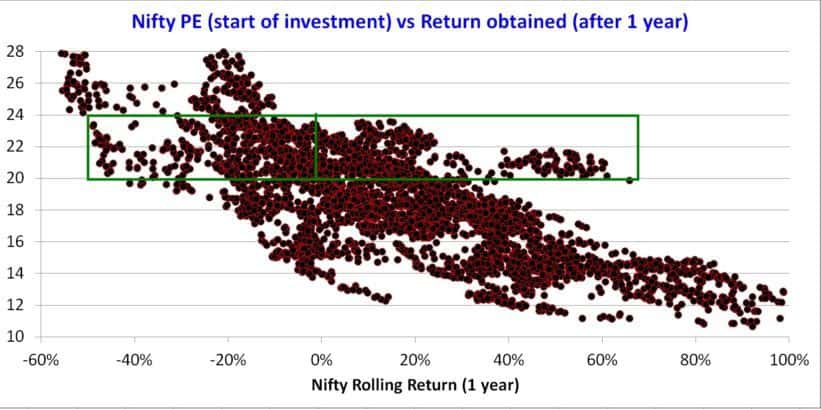 This is independent of bond yield. The green rectangle shows the returns for Nifty PE 20-24. The short dividing line inside the rectangle divides positive and negative returns. Notice that there are approximately equal no of points on either side of the divider.
This is independent of bond yield. The green rectangle shows the returns for Nifty PE 20-24. The short dividing line inside the rectangle divides positive and negative returns. Notice that there are approximately equal no of points on either side of the divider.
This means, investments made at high PE regardless of bond yield would result in a +ve or -ve return after one year with approximately equal probability.
Now we consider what happens to this probability or the number of +ve returns and -ve returns inside that box when the bond yield is considered.
The same graph as above, but only investments made when the bond yield is greater than or equal to 7% are considered. Hard to spot changes between the two graphs, aside from some points in low-PE region (<16) are missing here.
At least as of now, I am inclined to call any bond yield up to 7% as a low yield.
When investment are made at yields >= 8%, there is a marked change. The number of +ve and -ve returns have decreased, but there are more -ve returns inside than rectangle than positive.
This means that if you invest when the yield is 8% or higher and with a PE >20, there is a reasonable chance that the return after one year would be negative. However, it still does not preclude the possibility of a very good return.
This is merely an observation made with limited data. Please do not treat this as investment advice. I certainly am not going to.
Now for the record, let me complete this study with higher yields.
Returns when the investment was made at yield at 9% or higher.
Returns when the investment was made at yield at 10% or higher.
Returns when the investment was made at yield at 11% or higher.
Not much to say anything here.
Please do not conclude from this that PE+yield based investing ‘matters’. Sure it affects the probability of getting +ve returns over one-year. If I repeat this exercise over 10-years, there is nothing to shout about.
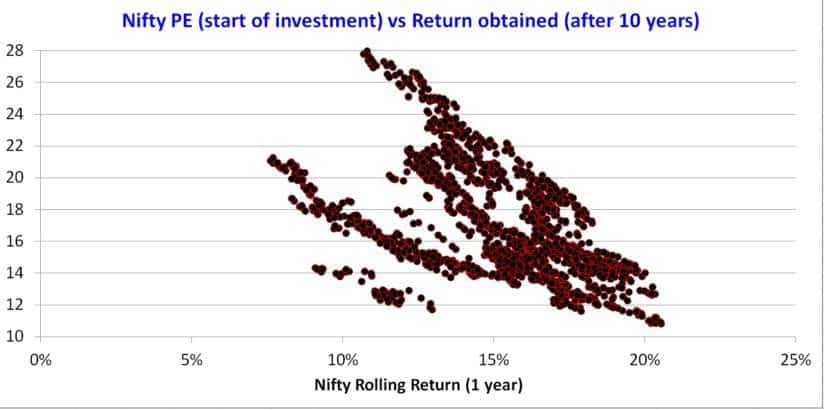

There is no significant change in PE 20-24 band aside from a handful of “low return” points which vanish from another branch. Since the use of a 10-year window significantly brings down the sample set, I do not wish to read too much into this.
We will have to constantly keep in mind that only 17.5 years of data is available to study. This limits the possibility of saying anything conclusive.
Finally, I would like to plot the PE and the product of PE and yield. Both are normalized with respect to their maximum value (since Jan. 1999).
Notice that the Nifty has fallen sharply at much lower PE levels (than 1, the max). And since 2008, it has not touched ‘1’.
When the PE x Yield product is considered, the recent highs are significantly lower. What we consider as ‘high PE’ and ‘high yield’ constantly changes with time. This makes it more difficult.
🔥Enjoy massive discounts on our courses, robo-advisory tool and exclusive investor circle! 🔥& join our community of 7000+ users!
Use our Robo-advisory Tool for a start-to-finish financial plan! ⇐ More than 2,500 investors and advisors use this!
Track your mutual funds and stock investments with this Google Sheet!
We also publish monthly equity mutual funds, debt and hybrid mutual funds, index funds and ETF screeners and momentum, low-volatility stock screeners.





- Do you have a comment about the above article? Reach out to us on Twitter: @freefincal or @pattufreefincal
- Have a question? Subscribe to our newsletter using the form below.
- Hit 'reply' to any email from us! We do not offer personalized investment advice. We can write a detailed article without mentioning your name if you have a generic question.
Join 32,000+ readers and get free money management solutions delivered to your inbox! Subscribe to get posts via email! (Link takes you to our email sign-up form)
About The Author
 Dr M. Pattabiraman(PhD) is the founder, managing editor and primary author of freefincal. He is an associate professor at the Indian Institute of Technology, Madras. He has over ten years of experience publishing news analysis, research and financial product development. Connect with him via Twitter(X), Linkedin, or YouTube. Pattabiraman has co-authored three print books: (1) You can be rich too with goal-based investing (CNBC TV18) for DIY investors. (2) Gamechanger for young earners. (3) Chinchu Gets a Superpower! for kids. He has also written seven other free e-books on various money management topics. He is a patron and co-founder of “Fee-only India,” an organisation promoting unbiased, commission-free investment advice.
Dr M. Pattabiraman(PhD) is the founder, managing editor and primary author of freefincal. He is an associate professor at the Indian Institute of Technology, Madras. He has over ten years of experience publishing news analysis, research and financial product development. Connect with him via Twitter(X), Linkedin, or YouTube. Pattabiraman has co-authored three print books: (1) You can be rich too with goal-based investing (CNBC TV18) for DIY investors. (2) Gamechanger for young earners. (3) Chinchu Gets a Superpower! for kids. He has also written seven other free e-books on various money management topics. He is a patron and co-founder of “Fee-only India,” an organisation promoting unbiased, commission-free investment advice.Our flagship course! Learn to manage your portfolio like a pro to achieve your goals regardless of market conditions! ⇐ More than 3,000 investors and advisors are part of our exclusive community! Get clarity on how to plan for your goals and achieve the necessary corpus no matter the market condition is!! Watch the first lecture for free! One-time payment! No recurring fees! Life-long access to videos! Reduce fear, uncertainty and doubt while investing! Learn how to plan for your goals before and after retirement with confidence.
Our new course! Increase your income by getting people to pay for your skills! ⇐ More than 700 salaried employees, entrepreneurs and financial advisors are part of our exclusive community! Learn how to get people to pay for your skills! Whether you are a professional or small business owner who wants more clients via online visibility or a salaried person wanting a side income or passive income, we will show you how to achieve this by showcasing your skills and building a community that trusts and pays you! (watch 1st lecture for free). One-time payment! No recurring fees! Life-long access to videos!
Our new book for kids: “Chinchu Gets a Superpower!” is now available!


Must-read book even for adults! This is something that every parent should teach their kids right from their young age. The importance of money management and decision making based on their wants and needs. Very nicely written in simple terms. - Arun.Buy the book: Chinchu gets a superpower for your child!
How to profit from content writing: Our new ebook is for those interested in getting side income via content writing. It is available at a 50% discount for Rs. 500 only!
Do you want to check if the market is overvalued or undervalued? Use our market valuation tool (it will work with any index!), or get the Tactical Buy/Sell timing tool!
We publish monthly mutual fund screeners and momentum, low-volatility stock screeners.
About freefincal & its content policy. Freefincal is a News Media Organization dedicated to providing original analysis, reports, reviews and insights on mutual funds, stocks, investing, retirement and personal finance developments. We do so without conflict of interest and bias. Follow us on Google News. Freefincal serves more than three million readers a year (5 million page views) with articles based only on factual information and detailed analysis by its authors. All statements made will be verified with credible and knowledgeable sources before publication. Freefincal does not publish paid articles, promotions, PR, satire or opinions without data. All opinions will be inferences backed by verifiable, reproducible evidence/data. Contact information: To get in touch, use this contact form. (Sponsored posts or paid collaborations will not be entertained.)
Connect with us on social media
- Twitter @freefincal
- Subscribe to our YouTube Videos
- Posts feed via Feedburner.
Our publications
You Can Be Rich Too with Goal-Based Investing
 Published by CNBC TV18, this book is meant to help you ask the right questions and seek the correct answers, and since it comes with nine online calculators, you can also create custom solutions for your lifestyle! Get it now.
Published by CNBC TV18, this book is meant to help you ask the right questions and seek the correct answers, and since it comes with nine online calculators, you can also create custom solutions for your lifestyle! Get it now.Gamechanger: Forget Startups, Join Corporate & Still Live the Rich Life You Want
 This book is meant for young earners to get their basics right from day one! It will also help you travel to exotic places at a low cost! Get it or gift it to a young earner.
This book is meant for young earners to get their basics right from day one! It will also help you travel to exotic places at a low cost! Get it or gift it to a young earner.Your Ultimate Guide to Travel
 This is an in-depth dive into vacation planning, finding cheap flights, budget accommodation, what to do when travelling, and how travelling slowly is better financially and psychologically, with links to the web pages and hand-holding at every step. Get the pdf for Rs 300 (instant download)
This is an in-depth dive into vacation planning, finding cheap flights, budget accommodation, what to do when travelling, and how travelling slowly is better financially and psychologically, with links to the web pages and hand-holding at every step. Get the pdf for Rs 300 (instant download)